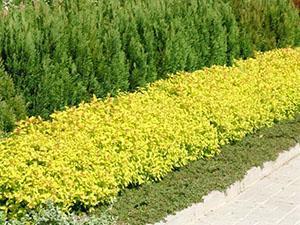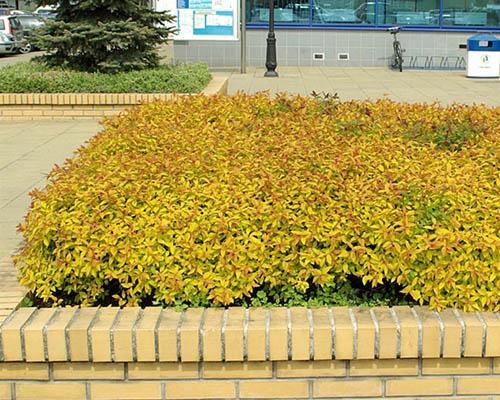Features of planting and care, photos of varieties of magnificent Japanese spirea
 Japanese spirea is a very popular shrub among landscape designers, and it gained this fame due to the fact that its decorative effect is preserved from early spring to the very first frosts. The price of planting material is low, and you can buy it in almost every nursery.
Japanese spirea is a very popular shrub among landscape designers, and it gained this fame due to the fact that its decorative effect is preserved from early spring to the very first frosts. The price of planting material is low, and you can buy it in almost every nursery.
For all its external beauty, Japanese spirea is easy to plant and care for. The peculiarity of this plant is that it is very hardy and can easily adapt to various natural conditions. On the territory of our country, it is grown almost everywhere, from the southern coast, to cold and arid regions. However, there are several varieties that can freeze under the conditions of a harsh winter, they need spring pruning, carried out for sanitary purposes, after which the bush will recover and bloom in the same year.
Japanese spirea needs 3-4 hours of direct sun during the day, when this minimum is fulfilled, the owner of the plant will be able to admire not only lush growth, but also abundant flowering. In constant sunlight, the shrub will naturally be even more luxurious.
Agrotechnical features of growing Japanese spirea

Spirea photo Japanese can often be found not only on the Internet, but also on the pages of monthly catalogs with planting materials, where many different varieties are offered to the attention of gardeners. Flowering begins in July and lasts until August. Only those shoots that have appeared on the plant this year thrive. The seeds ripen in October. Daughter plants take root easily. For successful rooting, you need to dig a hole, the size of which will correspond to the roots. If the soil is fertile, then planting will not require additional feeding. fertilizers... This shrub is often used as a hedge, for this purpose, for example, the Japanese Spiraea variety "Goldflame" is suitable.
Decorating a personal plot using Japanese spirea plantings
 The shrub looks bright all year round, therefore it is very convenient for decorating gardens. In its beauty there are no so-called “failures” affecting a certain season. The roots of the plant do not braid the roots of neighbors, and the bush itself does not differ in a large number of root stubs. The plant gets along well with any environment.
The shrub looks bright all year round, therefore it is very convenient for decorating gardens. In its beauty there are no so-called “failures” affecting a certain season. The roots of the plant do not braid the roots of neighbors, and the bush itself does not differ in a large number of root stubs. The plant gets along well with any environment.
Recommendation: the Japanese Spirea variety "Chrysla" can be used to create a shrub-woody group, in which its purpose will be to mask the open trunks of tall representatives.
Such as: chubushnik, lilac, magnolia. The compactness of the bush allows you to plant it even in flower beds with bulbs and annuals. They can also be used to decorate rockeries with low-growing perennials.Spirea is indispensable where it is necessary to create a single vivid image, for example, as a hedge, a dividing border, when planting slopes.
You need to cut the spirea plantings once a month, but the plant, of course, will not bloom. Therefore, before planting, it is advisable to decide in what capacity this shrub will be used, as an abundant flowering, or as a decorative leafy form. It lends itself to cutting perfectly, the bush is completely leafy and well developed. Some compact plants give wonderful golden foliage, such as the Japanese Spirea Goldmound.
Sanitary or anti-aging pruning is carried out so as not to violate the symmetry of the shoots. Only broken off branches and dead wood are cut out. Bushes that are more than 4 years old undergo more detailed pruning, several branches are removed from them up to the base of the trunk.
Decorative varieties of Japanese spirea: features and disadvantages
Japanese spirea, as the name implies, was brought to us from Japan, but it is also grown in China. A beautiful shrub with tomentose-pubescent shoots, oblong succulent leaves, green in the upper part and gray-gray underneath, which by autumn are colored with various shades of red-orange. Flowering lasts up to 50 days a year. This type of spirea has many varieties, which differ in the intensity of color and flowering, height, crown shape. In our country, the following are considered the most common varieties.
Japanese spirea variety "Little Princess"
 The plant forms a neat bush up to 60 cm in height, with a rounded compact crown, bluish-green foliage in the form of an elongated ellipse. Flowers of a pink shade, collected in a scale inflorescence. Flowering occurs in early to mid-summer. Shrub growth is slow. Looks great both in a single planting, and when landscaping forest edges, creating shrub groups, in hedge... Among the disadvantages of the variety, one can note the rapid loss of the intensity of the hue by flowers, which can fade in the bright sun.
The plant forms a neat bush up to 60 cm in height, with a rounded compact crown, bluish-green foliage in the form of an elongated ellipse. Flowers of a pink shade, collected in a scale inflorescence. Flowering occurs in early to mid-summer. Shrub growth is slow. Looks great both in a single planting, and when landscaping forest edges, creating shrub groups, in hedge... Among the disadvantages of the variety, one can note the rapid loss of the intensity of the hue by flowers, which can fade in the bright sun.
Japanese Spirea variety "Shirobana"
 A shrub reaching a height of 80cm. With dark green narrow lanceolate leaves, about 2.5 cm in length. The shade of flowers of this variety can be white or bright pink, and sometimes even red. It all depends on how lit the place where the bush grows. It blooms in July and plentifully produces new flower stalks until mid-August. This variety can diversify rock gardens, low curbs, compositions of conifers or other shrubs. The disadvantage of the variety is the untidiness of the bush, without cutting the spirea, it forms the crown chaotically.
A shrub reaching a height of 80cm. With dark green narrow lanceolate leaves, about 2.5 cm in length. The shade of flowers of this variety can be white or bright pink, and sometimes even red. It all depends on how lit the place where the bush grows. It blooms in July and plentifully produces new flower stalks until mid-August. This variety can diversify rock gardens, low curbs, compositions of conifers or other shrubs. The disadvantage of the variety is the untidiness of the bush, without cutting the spirea, it forms the crown chaotically.
Japanese spirea variety "Albiflora"
 She is white spirea. The height of the bush is 60 cm, and the flowers themselves are snow-white, which is very unusual for spirits that bloom in summer. During flowering, an indescribable, thick and rich aroma hovers over the bush. The foliage of the plant is green, oval in shape, and against its background, the white inflorescences look especially amazing. However, when blooming, the flower acquires a brownish-withered shade, therefore, such peduncles must be removed in a timely manner.
She is white spirea. The height of the bush is 60 cm, and the flowers themselves are snow-white, which is very unusual for spirits that bloom in summer. During flowering, an indescribable, thick and rich aroma hovers over the bush. The foliage of the plant is green, oval in shape, and against its background, the white inflorescences look especially amazing. However, when blooming, the flower acquires a brownish-withered shade, therefore, such peduncles must be removed in a timely manner.
Japanese spirea variety "Golden Princess"
 Interesting shrub, reaching a height of 50-60 cm, crown diameter span - 1 m and a little more. In spring, the foliage acquires a bright yellow tint, in summer it brightens, and in autumn the leaves turn orange, with soft undertones. The leaf is 7-8 cm long. Flowering is abundant and begins in June. The flowers themselves are pink or red-pink, collected in an inflorescence-scale, which can be up to 5 cm in diameter. The plant attracts many insects, so it is not recommended to plant it in places for walks and children's recreation.
Interesting shrub, reaching a height of 50-60 cm, crown diameter span - 1 m and a little more. In spring, the foliage acquires a bright yellow tint, in summer it brightens, and in autumn the leaves turn orange, with soft undertones. The leaf is 7-8 cm long. Flowering is abundant and begins in June. The flowers themselves are pink or red-pink, collected in an inflorescence-scale, which can be up to 5 cm in diameter. The plant attracts many insects, so it is not recommended to plant it in places for walks and children's recreation.
Spirea is often used as an ornamental groundcover, which gets along well with other low-growing plants, such as cinquefoil, lavender, St. John's wort, rudbeckia, yarrow and field herbs.Recently, this shrub can be found not only in private gardens, but also in city parks.